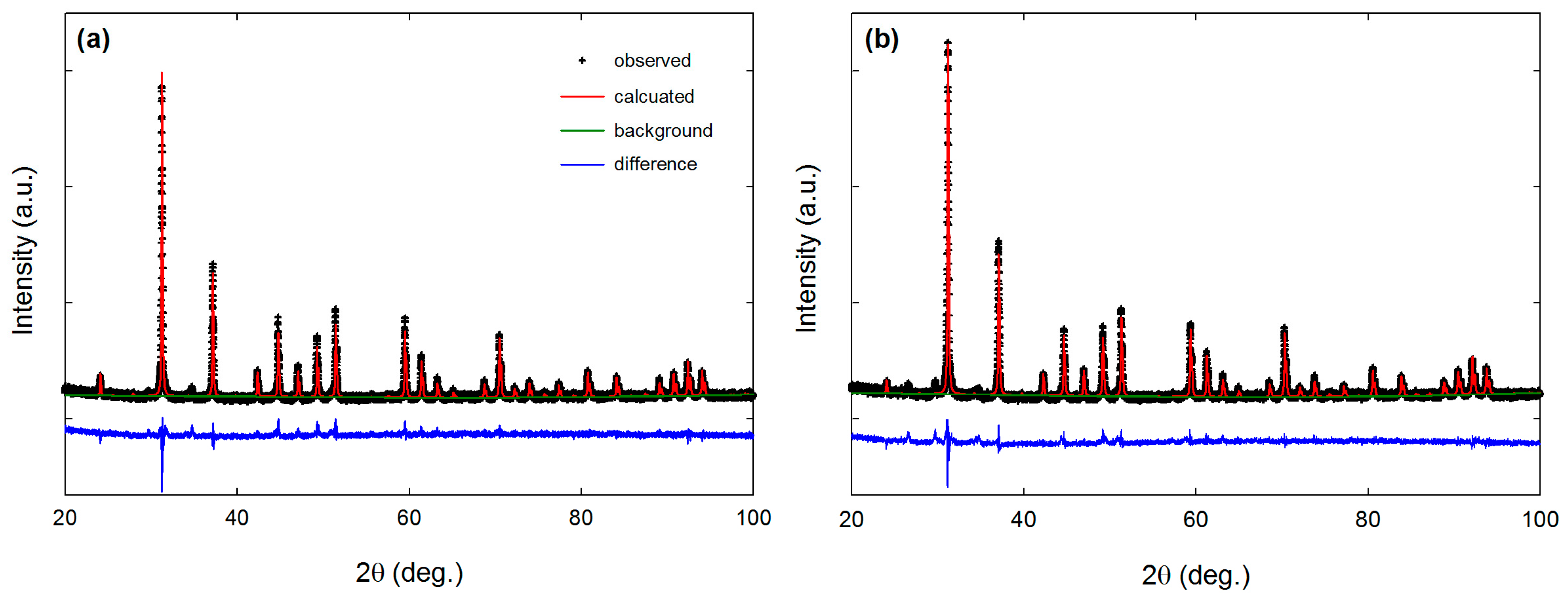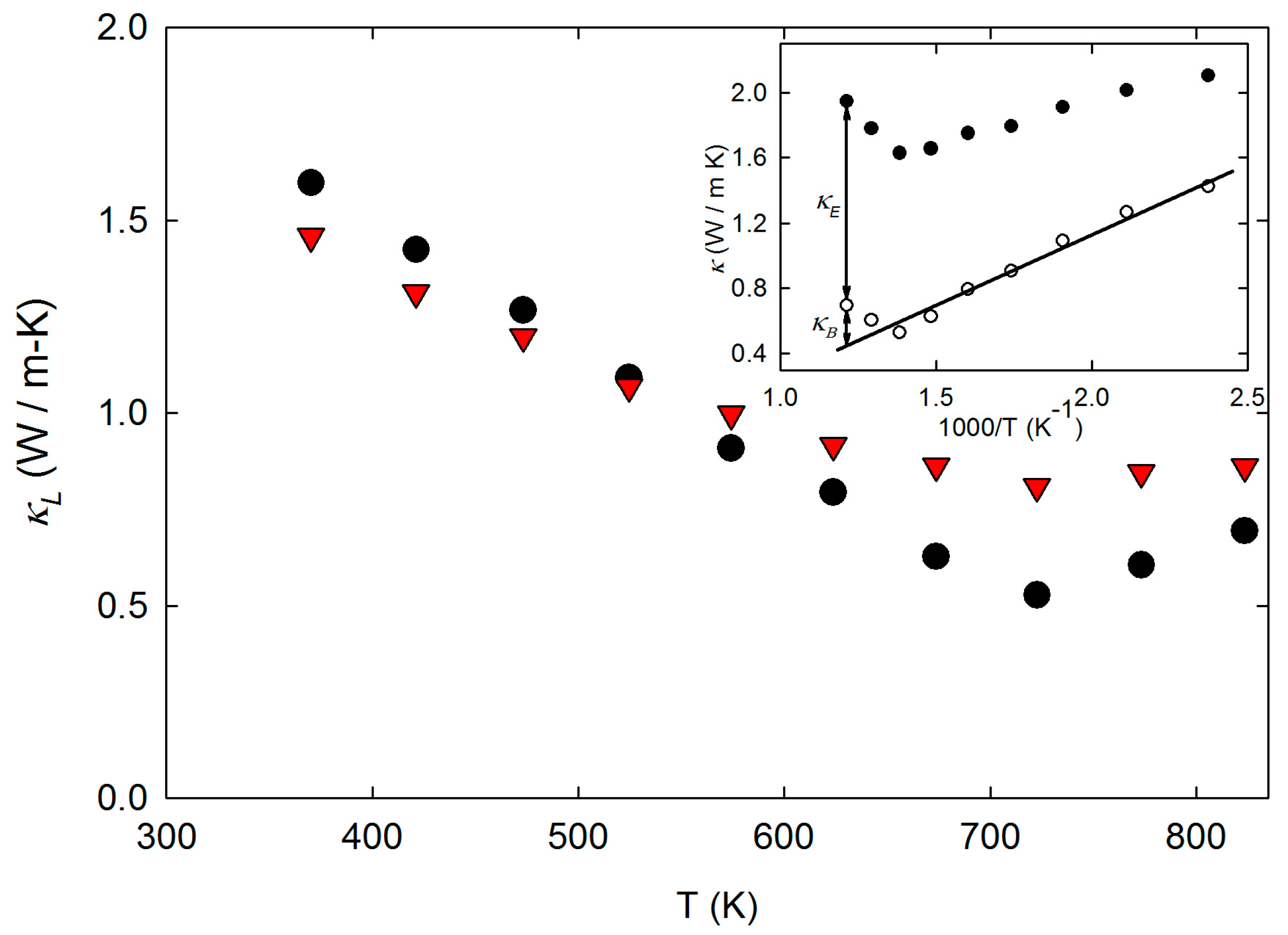High Temperature Transport Properties of Yb and In Double-Filled p-Type Skutterudites
Abstract
:1. Introduction
2. Experimental
3. Results
3.1. Structural Characterization
3.2. Transport Properties
4. Conclusions
Acknowledgments
Author Contributions
Conflicts of Interest
References
- Nolas, G.S.; Sharp, J.W.; Goldsmid, H.J. Thermoelectrics: Basic Principles and New Material Developments; Springer: Berlin, Germany, 2001. [Google Scholar]
- Stabler, F.R. Commercialization of Thermoelectric Technology. Mater. Res. Symp. Proc. 2006, 886, 13–21. [Google Scholar] [CrossRef]
- Uher, C. Skutterudites: Prospective novel thermoelectrics. In Semiconductors and Semimetals; Tritt, T.M., Ed.; Academic Press: San Diego, CA, USA, 2001; Volume 69, pp. 139–253. ISSN 978-0-12-752178-7. [Google Scholar]
- Dahal, T.; Kim, H.S.; Gahlawat, S.; Dahal, K.; Jie, Q.; Liu, W.; Lan, Y.; White, K.; Ren, Z. Transport and mechanical properties of the double-filled p-type skutterudites La0.68Ce0.22Fe4-xCoxSb12. Acta Mater. 2016, 117, 13–22. [Google Scholar] [CrossRef]
- Salvador, J.R.; Yang, J.; Shi, X.; Wang, H.; Wereszczak, A.A.; Kong, H.; Uher, C. Transport and mechanical properties of Yb-filled skutterudites. Philos. Mag. 2009, 89, 1517–1534. [Google Scholar] [CrossRef]
- Zhang, L.; Rogl, G.; Grytsiv, A.; Puchegger, S.; Koppensteiner, J.; Spieckermann, F.; Kabelka, H.; Reinecker, M.; Rogl, P.; Schranz, W.; et al. Mechanical properties of filled antimonide skutterudites. Mater. Sci. Eng. B 2010, 170, 26–31. [Google Scholar] [CrossRef]
- Nolas, G.S.; Fowler, G. Partial filling of skutterudites: Optimization for thermoelectric applications. J. Mater. Res. 2005, 20, 3234–3237. [Google Scholar] [CrossRef]
- Nolas, G.S.; Morelli, D.T.; Tritt, T.M. Skutterudites: A phonon-glass-electron-crystal approach to advanced thermoelectric energy conversion applications. Annu. Rev. Mater. Res. Bull. 1999, 29, 199–205. [Google Scholar] [CrossRef]
- Nolas, G.S.; Kaeser, M.; Littleton, R.T.; Tritt, T.M. High figure of merit in partially filled ytterbium skutterudite materials. Appl. Phys. Lett. 2000, 77, 1855. [Google Scholar] [CrossRef]
- Peng, J.Y.; Alboni, P.N.; He, J.; Zhang, B.; Su, Z.; Holgate, T.; Gothard, N.; Tritt, T.M. Thermoelectric properties of (In,Yb) double-filled CoSb3 skutterudite. J. Appl. Phys. 2008, 104, 053710. [Google Scholar] [CrossRef]
- Dong, Y.; Puneet, P.; Tritt, T.M.; Nolas, G.S. Crystal structure and high temperature transport properties of Yb-filled p-type skutterudites YbxCo2.5Fe1.5Sb12. J. Solid State Chem. 2014, 209, 1–5. [Google Scholar] [CrossRef]
- Dong, Y.; Puneet, P.; Tritt, T.M.; Nolas, G.S. High temperature thermoelectric properties of p-type skutterudites YbxCo3FeSb12. Phys. Status Solidi RRL 2013, 7, 418–420. [Google Scholar] [CrossRef]
- Zhao, D.; Tian, C.; Tang, S.; Liu, Y.; Chen, L.D. High temperature oxidation behavior of cobalt triantimonide thermoelectric material. J. Alloys Compd. 2010, 504, 552–558. [Google Scholar] [CrossRef]
- Shin, D.K.; Kim, I.H.; Park, K.H.; Lee, S.; Seo, W.S. Thermal Stability of La0.9Fe3CoSb12. J. Electron. Mater. 2015, 44, 1858–1863. [Google Scholar] [CrossRef]
- Dong, Y.; Puneet, P.; Tritt, T.M.; Martin, J.; Nolas, G.S. High temperature thermoelectric properties of p-type skutterudites BaxYbyCo4-zFezSb12. J. Appl. Phys. 2012, 112, 083718. [Google Scholar] [CrossRef]
- Liu, R.; Chen, X.; Qiu, P.; Liu, J.; Yang, J.; Huang, X.; Chen, L. Low thermal conductivity and enhanced thermoelectric performance of Gd-filled skutterudites. J. Appl. Phys. 2011, 109, 023719. [Google Scholar] [CrossRef]
- Zhou, C.; Morelli, D.; Zhou, X.; Wang, G.; Uher, C. Thermoelectric properties of P-type Yb-filled skutterudite YbxFeyCo4-ySb12. Intermetallics 2011, 19, 1390–1393. [Google Scholar] [CrossRef]
- Slack, G.A.; Hussain, M.A. The maximum possible conversion efficiency of silicon-germanium thermoelectric generators. J. Appl. Phys. 1991, 70, 2694. [Google Scholar] [CrossRef]
- Cho, J.Y.; Ye, Z.; Tessema, M.M.; Waldo, R.A.; Salvador, J.R.; Yang, J.; Cai, W.; Wang, H. Thermoelectric properties of p-type skutterudites YbxFe3.5Ni0.5Sb12 (0.8 < x < 1). Acta Mater. 2012, 60, 2104–2110. [Google Scholar]
- Tang, X.; Li, H.; Zhang, Q.; Niino, M.; Goto, T. Synthesis and thermoelectric properties of double-atom-filled skutterudite compounds CamCenFexCo4-xSb12. J. Appl. Phys. 2006, 100, 123702. [Google Scholar] [CrossRef]
- Yang, K.; Cheng, H.; Hng, H.H.; Ma, J.; Mi, J.L.; Zhao, X.B.; Zhu, T.J.; Zhang, Y.B. Synthesis and thermoelectric properties of double-filled skutterudites CeyYb0.5-yFe1.5Co2.5Sb12. J. Alloys Compd. 2009, 467, 528–532. [Google Scholar] [CrossRef]
- Zhao, W.; Wei, P.; Zhang, Q.; Dong, C.; Liu, L.; Tang, X. Enhanced Thermoelectric Performance in Barium and Indium Double-Filled Skutterudite Bulk Materials via Orbital Hybridization Induced by Indium Filler. J. Amer. Chem. Soc. 2009, 131, 3713–3720. [Google Scholar] [CrossRef] [PubMed]
- Jie, Q.; Wang, H.; Liu, W.; Wang, H.; Chen, G.; Ren, Z. Fast Phase formation of double-filled p-type skutterudites by ball-milling and hot-pressing. Phys. Chem. Chem. Phys. 2013, 15, 6809–6816. [Google Scholar] [CrossRef] [PubMed]
- Joo, G.S.; Shin, D.K.; Kim, I.H. Synthesis and Thermoelectric Properties of p-Type Double-Filled Ce1-zYbzFe4-xCoxSb12 Skutterudites. J. Electron. Mater. 2016, 45, 1251–1256. [Google Scholar] [CrossRef]




| Nominal Composition | Yb0.4In0.02Co3FeSb12 | Yb0.8In0.02Co2.5Fe1.5Sb12 |
| Composition | Yb0.13In0.02Co3FeSb12 | Yb0.39In0.02Co2.4Fe1.6Sb12 |
| Space Group (Z) | Im (#204), 8 | |
| a (Å) | 9.0660(6) | 9.0872(8) |
| V (Å3) | 745.1(7) | 750.4(2) |
| Radiation | Graphite Monochromated CuKα (1.54056 A) | |
| Dcalc. (g/cm3) | 6.43 | 7.17 |
| 2θ range (deg.) | 20–100 | 2–100 |
| Step Width (deg.) | 0.005 | 0.005 |
| Reduced χ2 | 2.40 | 2.84 |
| wRp, Rp | 0.0739, 0.0581 | 0.0779, 0.0610 |
| Uiso (Å2) for Yb | 0.0095(0) | 0.0125(6) |
| Uiso (Å2) for In | 0.0090(3) | 0.0101(7) |
| Uiso (Å2) for Co/Fe | 0.0070(1) | 0.0039(4) |
| Uiso (Å2) for Sb | 0.0037(4) | 0.0041(2) |
| y (Sb) | 0.8436(7) | 0.8423(6) |
| z (Sb) | 0.6654(4) | 0.6649(9) |
© 2017 by the authors. Licensee MDPI, Basel, Switzerland. This article is an open access article distributed under the terms and conditions of the Creative Commons Attribution (CC BY) license (http://creativecommons.org/licenses/by/4.0/).
Share and Cite
Hobbis, D.; Liu, Y.; Wei, K.; Tritt, T.M.; Nolas, G.S. High Temperature Transport Properties of Yb and In Double-Filled p-Type Skutterudites. Crystals 2017, 7, 256. https://doi.org/10.3390/cryst7090256
Hobbis D, Liu Y, Wei K, Tritt TM, Nolas GS. High Temperature Transport Properties of Yb and In Double-Filled p-Type Skutterudites. Crystals. 2017; 7(9):256. https://doi.org/10.3390/cryst7090256
Chicago/Turabian StyleHobbis, Dean, Yamei Liu, Kaya Wei, Terry M. Tritt, and George S. Nolas. 2017. "High Temperature Transport Properties of Yb and In Double-Filled p-Type Skutterudites" Crystals 7, no. 9: 256. https://doi.org/10.3390/cryst7090256
APA StyleHobbis, D., Liu, Y., Wei, K., Tritt, T. M., & Nolas, G. S. (2017). High Temperature Transport Properties of Yb and In Double-Filled p-Type Skutterudites. Crystals, 7(9), 256. https://doi.org/10.3390/cryst7090256






